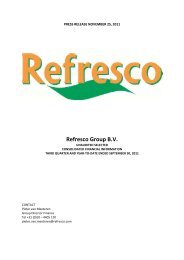measure and monitor the processes and report results ... - Refresco.de
measure and monitor the processes and report results ... - Refresco.de
measure and monitor the processes and report results ... - Refresco.de
Create successful ePaper yourself
Turn your PDF publications into a flip-book with our unique Google optimized e-Paper software.
Business review 2010<br />
Review 2010<br />
Looking back on 2010 we can state that <strong>the</strong> year started relatively smoothly, with a turning point mid-year where<br />
we had to face major challenges. Our business was influenced by several factors: a persistently tough economic<br />
situation, changing consumer behavior, customers <strong>and</strong> suppliers consolidating, <strong>and</strong> steeply rising commodity prices.<br />
<strong>de</strong>spite <strong>the</strong>se difficult market circumstances <strong>Refresco</strong> has been able to achieve its financial targets. We managed to<br />
grow our business, <strong>and</strong> were able to execute our acquisition strategy. Revenue increased with 7.4% to a level above<br />
last year at EuR 1.224 billion.<br />
The market<br />
In 2010 <strong>the</strong> economic situation was still challenging for many<br />
companies. The economic downturn of 2009 is by far not over,<br />
as we can see in our industry <strong>and</strong> retail data. In fact we can say<br />
that <strong>the</strong> consequences will continue to affect our industry for<br />
several years to come. Where in 2009 <strong>the</strong> effects were limited<br />
to financial institutions, in 2010 <strong>the</strong>y spread to o<strong>the</strong>r industries<br />
as well. Unemployment rates climbed in more <strong>and</strong> more<br />
European countries, leading to changing consumer behavior.<br />
Consumer behavior has become even more unpredictable than<br />
before, <strong>and</strong> spending per head has gone down in every single<br />
category, including food <strong>and</strong> beverages. This has led to <strong>the</strong> emergence<br />
of massive opportunistic shopping behavior, with consumers<br />
travelling from shop to shop to find <strong>the</strong> cheapest products<br />
<strong>and</strong> <strong>the</strong> best promotions. Ano<strong>the</strong>r trend we see is consumers<br />
moving from expensive product propositions to cheaper ones.<br />
In our own product range, for instance, we have seen a shift from<br />
100% orange juice to juice drinks or nectars, <strong>and</strong> beyond <strong>the</strong><br />
juice category to <strong>the</strong> cheaper carbonated soft drinks (CSDs).<br />
Among our customers, we see on <strong>the</strong> one h<strong>and</strong> retailers<br />
competing fiercely on price, leading to allout price wars on<br />
<strong>the</strong> o<strong>the</strong>r h<strong>and</strong> is a consolidation in retailers’ buying to be able<br />
to benefit from highvolume buying. More <strong>and</strong> more retailers<br />
are joining large national or international buying groups such<br />
as EMD, AMS, Agenor etc. Meanwhile retailers (including hard<br />
discounters) are becoming more opportunistic. They will readily<br />
give up <strong>the</strong>ir own private label product if <strong>the</strong>y get <strong>the</strong> opportunity<br />
to increase <strong>the</strong>ir margin on an Abr<strong>and</strong>.<br />
Abr<strong>and</strong>s, on <strong>the</strong> o<strong>the</strong>r h<strong>and</strong>, are stepping up <strong>the</strong>ir price promotions<br />
to be able to maintain <strong>the</strong>ir sales volumes. This in fact<br />
encourages consumers to look for price promotions <strong>and</strong> only<br />
buy certain products if <strong>the</strong>se are on promotion, thus fur<strong>the</strong>r<br />
enhancing <strong>the</strong>ir opportunistic buying behavior. As a result <strong>the</strong><br />
market share of private label products has stabilized in 2010.<br />
In <strong>the</strong> second half of 2010, prices of all raw materials <strong>and</strong><br />
packaging materials showed explosive growth. This was partly<br />
caused by poor harvests (orange, apple, pineapple, sugar,<br />
cotton), but also by rising oil prices <strong>and</strong> investors massively<br />
buying commodities to benefit from expected economic recovery.<br />
Every year we are faced with movements in <strong>the</strong> pricing<br />
of raw materials <strong>and</strong> packaging materials, but this year price<br />
increases have been substantial, <strong>and</strong> volatility of <strong>the</strong> prices has<br />
been high, across <strong>the</strong> entire range of raw materials.







